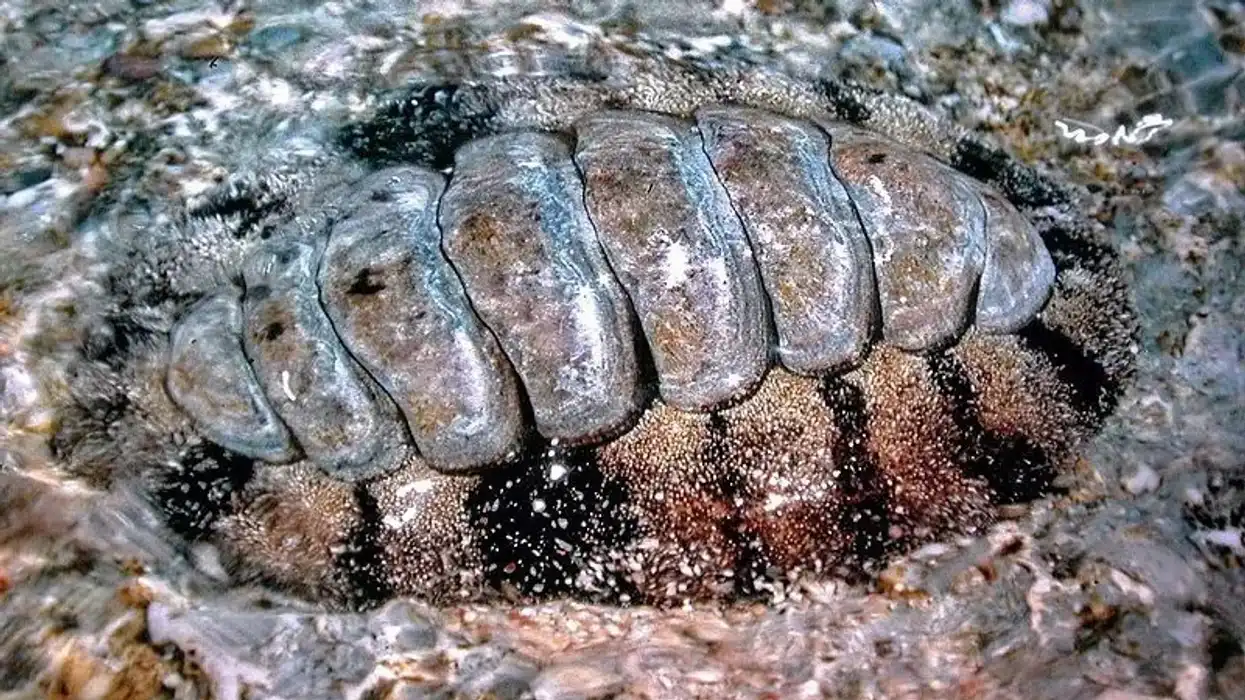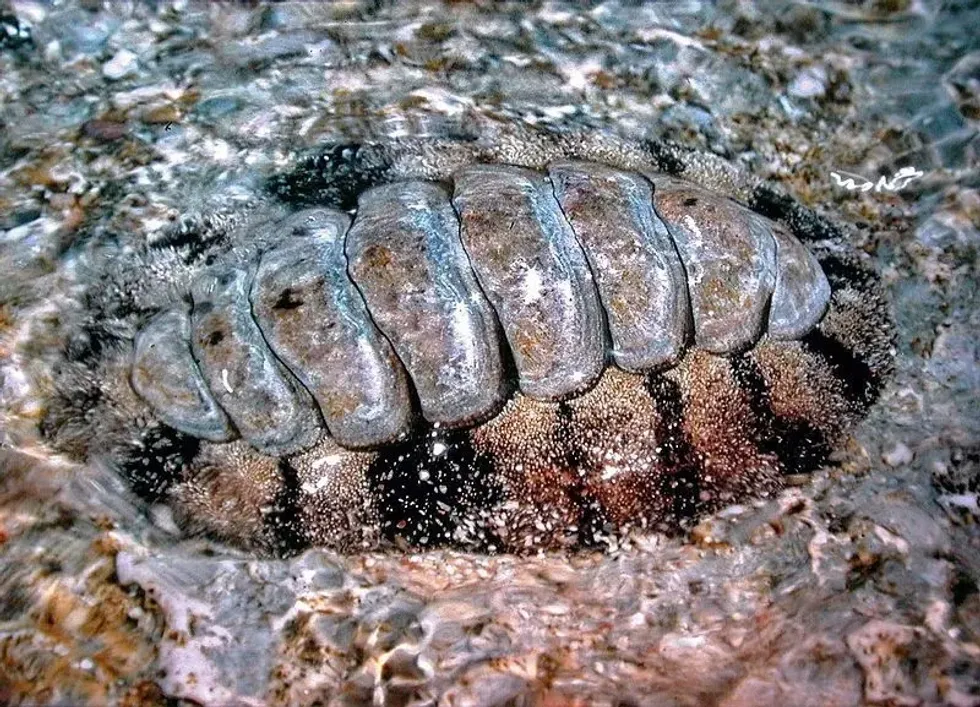Chiton (phylum mollusca) is a type of shelled animal that has been on our planet for a long time. These creatures belong to the class Polyplacophora, whose name comes from a Greek word. This Greek word means 'many plates', which refers to the eight shell plates on the body of a chiton.
Chitons have one foot and a radula. While these creatures use the foot to attach themselves to rocks, the radula helps scrape rock surfaces. Over 900 species of chitons live in this world today, and all of them have different traits. Keep reading to know more chiton facts!
Chiton Interesting Facts
What type of animal is a chiton?
Chitons are a type of shell animal or mollusks that live in the sea. They are also known as sea cradles or loricates and are unique because of shell plates on their bodies.
What class of animal does a chiton belong to?
The mollusk class that chitons come under is Polyplacophora. This word literally translates to 'many plates', and this class consists of many shell animals still alive worldwide.
How many chitons are there in the world?
Since these are deep-sea mollusk animals, there is no conclusive evidence on the number of chitons in the world. However, the adaptations made by the chiton species through years of evolution support the notion that they are available in large numbers.
Where does a chiton live?
Chitons are marine shell animals that have a long history. They are found under sea surfaces. While most chiton species live in intertidal zones surrounded by plenty of light, others can be found in subtidal areas. They live surrounded by rocks and in rock crevices, where they are guarded against threats.
What is a chiton's habitat?
Shell animals of the Polyplacophora class are found across the world. This is because the many marine species of the class Polyplacophora are highly adaptive, and their structure supports life in many different places.
Who do chitons live with?
Chiton biology and characteristics throw little to no light on the social behavior of this species. However, it is tough to assume that these marine shell animals would have a very sociable nature.
How long does a chiton live?
The lifespan of a chiton is around three years.
How do they reproduce?
Chitons can be oviparous or viviparous in nature, depending upon the type of chiton in question. Most of these shell creatures reproduce through external fertilization. In contrast, some female chitons keep fertilized eggs inside their ovary until the time for hatching arrives, while others release eggs individually or in strings to be fertilized by males.
What is their conservation status?
According to the IUCN (International Union for Conservation of Nature) Red List, the conservation status of chitons is Not Extinct. This means that while the shells of these creatures and their love for rocks do guard them to a certain extent, they are not entirely safe from the threat of extinction.
This fact is further made scary when we note that there are hundreds of extinct chiton species!
Chiton Fun Facts
What do chitons look like?
Chitons are related to snails, mussels, and oysters due to them being in the same phylum. One of the main chiton characteristics is that these creatures have eight shell plates on their body, which are arranged in a slightly overlapping structure.
The overlapping arrangement is such that the dorsal plates allow chitons to convert into a ball-like shape when a threat is around. These shells are surrounded by a girdle. This girdle is known as a skirt and can cover the plates to different extents.
The eight plates also inspire the word for the name of the class that chitons belong to. The word Polyplacophora comes from a Greek word. This word means many plates.
The body of loricates or sea cradles can be covered in any length of shell plates and can be of various colors as well. They have a mouth on the underside of their shell body.
Chitons have only one foot. This foot serves the primary purpose of clinging onto rocks. They also have a radula, tiny teeth-like structures used to scrape rocks.

How cute are they?
Some chitons, such as the lined chiton, seem very cute in their natural habitat. Their ability to change shape and turn into a ball is also pretty commendable. Furthermore, the shell length varies across chiton species, and hence, everyone is bound to find one that looks best to them.
How do they communicate?
Although they have a mouth and can move around a little with the help of their singular foot, it is unclear if the chiton species has many modes of communication.
How big is a chiton?
The size of a chiton, also called a loricate, is usually 2 in (5 cm). Understandably, these creatures are pretty small and require much protection in their natural habitat. One species, Cryptochiton stelleri, reaches up to lengths of 17 in (43 cm).
How fast can a chiton swim?
Chitons have only one foot on their dorsal surfaces, which they use for clinging onto rocks. It is deemed impossible for these shelled creatures to show large amounts of movement. Hence, it is safe to assume that a chiton's foot allows it a negligible speed, if at all any!
How much does a chiton weigh?
Unfortunately, there are no records that can tell the average weight of chitons. However, given their small size, we can safely assume that these creatures have negligible weight.
What are male and female names of the species?
There are no notable names for male and female chitons. Hence, we lovingly refer to them as the male chiton and the female chiton.
What would you call a baby chiton?
There are no special names for a baby chiton either. One of the interesting facts about a baby chiton is that it is born with primitive features compared to those of mature chitons.
What do they eat?
While some chiton species are herbivorous and eat plankton, others are carnivorous. Chitons can both scrape algae from rocks and eat small invertebrates and fish that are readily available in their marine habitat.
Are they dangerous?
There is no evidence that would suggest that chitons are dangerous. They are tiny creatures that can hardly move and are consumed in many parts of the world.
Would they make a good pet?
Chitons, also called sea cradles and loricates, are not common pets. This is due to the fact that they attach themselves to rock surfaces and do not have much of a range in movement. It would also be impeccably tough to take care of such a creature, given its diet.
Did you know...
The shell plates that the upper body of a chiton is covered in can either be loose or tightly bound. This would not affect the movement or life of a chiton in any way. Chiton adaptations allow these creatures to turn into a ball upon sensing danger to protect them from any life-threatening impacts.
Can you eat chitons?
Chitons are consumed in many parts of the world, such as the Caribbean Islands. People of Trinidad and Tobago, the Bahamas, St Maarten, and Barbados frequently indulge in these shelled creatures.
Are chitons reef safe?
While some chitons are reef safe, others are not. This is one of the reasons why this species must be identified before making any assumptions.










